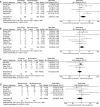A Systematic Review and Meta-Analysis of Cancer Patients Affected by a Novel Coronavirus
- PMID: 33875976
- PMCID: PMC7928783
- DOI: 10.1093/jncics/pkaa102
A Systematic Review and Meta-Analysis of Cancer Patients Affected by a Novel Coronavirus
Abstract
Background: Cancer patients with coronavirus disease 2019 (COVID-19) have been reported to have double the case fatality rate of the general population.
Methods: A systematic search of PubMed, Embase, and Cochrane Central was done for studies on cancer patients with COVID-19. Pooled proportions were calculated for categorical variables. Odds ratio (OR) and forest plots (random-effects model) were constructed for both primary and secondary outcomes.
Results: This systematic review of 38 studies and meta-analysis of 181 323 patients from 26 studies included 23 736 cancer patients. Our meta-analysis shows that cancer patients with COVID-19 have a higher likelihood of death (n = 165 980, OR = 2.54, 95% confidence interval [CI] = 1.47 to 4.42), which was largely driven by mortality among patients in China. Cancer patients were more likely to be intubated. Among cancer subtypes, the mortality was highest in hematological malignancies (n = 878, OR = 2.39, 95% CI = 1.17 to 4.87) followed by lung cancer (n = 646, OR = 1.83, 95% CI = 1.00 to 3.37). There was no association between receipt of a particular type of oncologic therapy and mortality. Our study showed that cancer patients affected by COVID-19 are a decade older than the normal population and have a higher proportion of comorbidities. There was insufficient data to assess the association of COVID-19-directed therapy and survival outcomes in cancer patients.
Conclusion: Cancer patients with COVID-19 disease are at increased risk of mortality and morbidity. A more nuanced understanding of the interaction between cancer-directed therapies and COVID-19-directed therapies is needed. This will require uniform prospective recording of data, possibly in multi-institutional registry databases.
© The Author(s) 2021. Published by Oxford University Press.
Figures




Update of
-
A systematic review and meta-analysis of cancer patients affected by a novel coronavirus.medRxiv [Preprint]. 2020 May 29:2020.05.27.20115303. doi: 10.1101/2020.05.27.20115303. medRxiv. 2020. Update in: JNCI Cancer Spectr. 2021 Feb 24;5(2):pkaa102. doi: 10.1093/jncics/pkaa102. PMID: 32511470 Free PMC article. Updated. Preprint.
References
-
- Coronavirus 2019-nCoV, CSSE. Coronavirus 2019-nCoV global cases by Johns Hopkins CSSE. https://gisanddata.maps.arcgis.com/apps/opsdashboard/index. Accessed October 7, 2020.
-
- World Health Organization International Agency for Research on Cancer (IARC). GLOBOCAN 2018: estimated cancer incidence, mortality and prevalence worldwide in 2018; 2020. https://gco.iarc.fr/today/data/factsheets/cancers/39-All-cancers-fact-sh....
-
- https://canceratlas.cancer.org/the-burden/cancer-survivorship/. Accessed May 23, 2020.
-
- Gao Y, Liu M, Shi S, et al. Cancer is associated with the severity and mortality of patients with COVID-19: a systematic review and meta-analysis. 2020; doi: 2020.2005.2001.20087031.
Publication types
MeSH terms
LinkOut - more resources
Full Text Sources
Other Literature Sources
Medical
